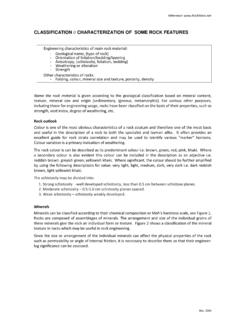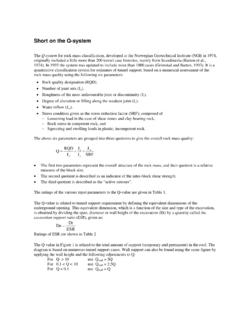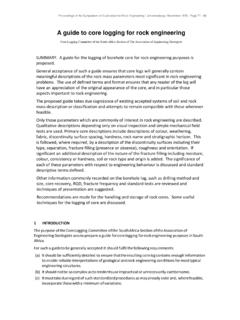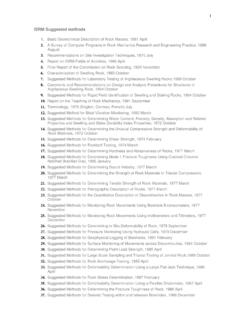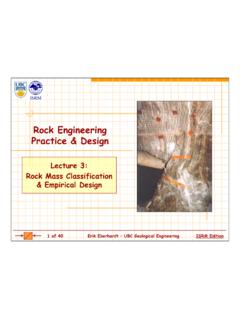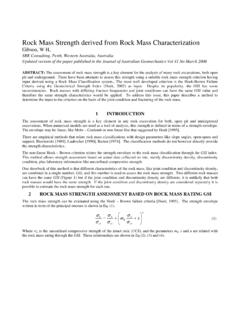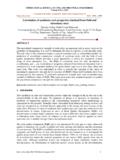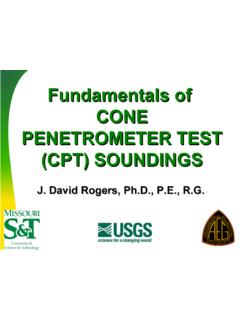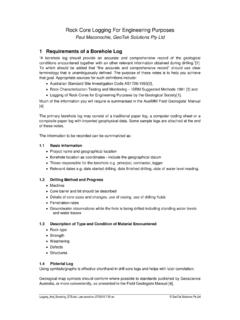Transcription of CLASSIFICATION // CHARACTERIZATION OF SOME ROCK …
1 Reference: Dec. 2014 CLASSIFICATION // CHARACTERIZATION OF some ROCK FEATURES Engineering characteristics of main rock material: - Geological name, (type of rock) - Orientation of foliation/bedding/layering - Anisotropy, (schistosity, foliation, bedding) - Weathering or alteration - Strength Other characteristics of rocks : - Folding, colour, mineral size and texture, porosity, density Name the rock material is given according to the geological CLASSIFICATION based on mineral content, texture, mineral size and origin (sedimentary, igneous, metamorphic).
2 For various other purposes, including those for engineering usage, rocks have been classified on the basis of their properties, such as strength, void index, degree of weathering, etc. Rock outlook Colour is one of the most obvious characteristics of a rock stratum and therefore one of the most basic and useful in the description of a rock to both the specialist and layman alike. It often provides an excellent guide for rock strata correlation and may be used to identify various "marker" horizons. Colour variation is a primary indication of weathering.
3 The rock colour is can be described as its predominant colour brown, green, red, pink, khaki. Where a secondary colour is also evident this colour can be included in the description as an adjective reddish brown, greyish green, yellowish khaki. Where significant, the colour should be further amplified by using the following descriptions for value: very light, light, medium, dark, very dark dark reddish brown, light yellowish khaki. The schistosity may be divided into: 1. Strong schistosity -well developed schistosity, less than cm between schistose planes.
4 2. Moderate schistosity cm schistosity planes spaced. 3. Weak schistosity schistosity weakly developed. Minerals Minerals can be classified according to their chemical composition or Moh's hardness scale, see Figure 1. rocks are composed of assemblages of minerals. The arrangement and size of the individual grains of these minerals give the rock an individual form or texture. Figure 2 shows a CLASSIFICATION of the mineral texture in rocks which may be useful in rock engineering. Since the size or arrangement of the individual minerals can affect the physical properties of the rock such as permeability or angle of internal friction, it is necessary to describe them so that their engineer- log significance can be assessed.
5 2 Figure 1: Hardness of some minerals. More can be found in textbooks, Dana's Manual of Mineralogy. John Wiley & sons, 609 p. Figure 2: CHARACTERIZATION of mineral texture in rocks (from NBG (1985, 2000) Mineral size, or grain size in sedimentary rocks , is a noticeable textural feature. The CLASSIFICATION in Table 1 is been based on visual identification using a hand lens. For metamorphic and igneous rocks the same reasoning is applicable, with a grain size qualification only being necessary in the coarser grained rocks . Table 1: CLASSIFICATION of mineral size (from 'A guide to core logging for rock engineering', 1976, 15 p.))
6 DESCRIPTION SIZE IN mm RECOGNITION EQUIV. SOIL TYPE Very fine grained < Individual grains cannot be seen with a hand lens Clays & Silts Fine grained - 0,2 Just visible as individual grains under hand lens Fine sand Medium grained Grains clearly visible under hand lens, just visible to the naked eye Medium sand Coarse grained Grains clearly visible to naked eye Coarse sand Very Coarse Grained > - Grains measureable Gravel 3 Table 2: Goodman's engineering CLASSIFICATION of rocks (from Goodman, 1989) ENGINEERING CLASSIFICATION OF rocks EXAMPLES I Crystalline texture A.
7 Soluble carbonates and salts Limestone, dolomite, marble, rock salt, gypsum B. Mica or other planar minerals in continuous bands Mica schist, chlorite schist, graphite schist C. Banded silicate minerals without continuous mica sheets Gneiss D. Randomly oriented and distributed silicate minerals of uniform grain size Granite, diorite, gabbro, syenite E. Randomly oriented and distributed silicate minerals in a background of very fine grain and with vugs Basalt, rhyolite, other volcanic rocks F. Highly sheared rocks Serpentinite, mylonite II Clastic texture A.
8 Stably cemented Silica-cemented sandstones and limonite sandstones B. With slightly soluble cement Calcite-cemented sandstone and conglomerate C. With highly soluble cement Gypsum-cemented sandstone and conglomerate D. Incompletely or weakly cemented Friable sandstone, tuff E. Uncemented Clay-bound sandstones III Very fine-grained rocks A. Isotropic, hard rocks Hornfels, some basalts B. Anisotropic on a macro scale, but microscopically isotropic hard rocks Cemented shales, flagstones C. Microscopically anisotropic hard rocks Slate, phyllite D.
9 Soft, soil-like rocks Compaction shale, chalk, marl IV Organic rocks A. Soft coal Lignite and bituminous coal B. Hard coal C. Oil shale D. Bituminous shale E. Tar sand Weathering / alteration of rock The process of weathering/alteration is by means of mechanical, chemical and biological action which drastically affects the engineering properties of both the rock material and the rock mass. some of the more important effects of weathering/alteration on rock are the decrease in strength, density and volumetric stability and the increase in deformability, porosity and weatherability.
10 Table 3: The CLASSIFICATION of weathering/alteration is as follows: Term *) Description Unweathered/unaltered No visible signs of alteration in the rock material out fracture planes may be stained or discoloured. Slightly weathered /altered Fractures are stained or discoloured and may contain a thin filling of altered material. Discolouration may extend into the rock from the fracture planes to a distance of up to 20% of the fracture spacing ( less than 4o% of the core is discoloured). Medium weathered/altered Slight discolouration extends from fracture planes for a distance greater than 20% of the fracture spacing ( generally greater part of the rock).
